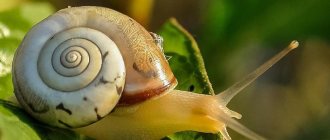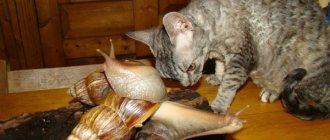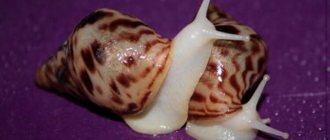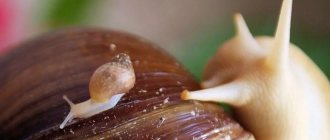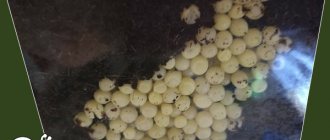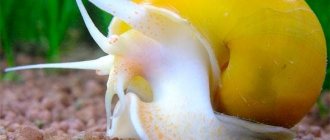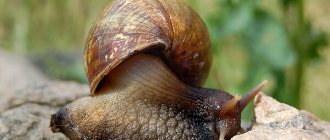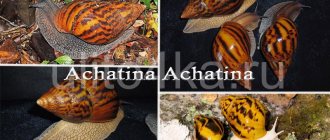Keeping Achatina snails at home: why do they die?
The most common problem that breeders may encounter is shell injury.
It often happens that a snail, crawling along the lid of a container, falls off and falls down. Such falls do not always end successfully, and this can lead to cracks or chipping of the shell. However, it is not at all difficult to get rid of this problem. To do this, you just need to lubricate the damaged area with an antiseptic. This will help the mollusk’s body heal the injury faster. During the healing period, it is better to place the injured individual in a separate place, since snails really like to rub their shells with each other. In order for your pets to get sick as little as possible, you need to clean out any missing food residues from the terrarium at least once. Also, you should not handle them too often; the skin of mollusks is very delicate and can easily be infected by microorganisms.
That's all you need to know about keeping such exotic pets as Achatina snails. Keep the terrarium clean, feed your snails regularly and variedly, monitor their health, and Achatina will delight you and your loved ones for many, many years to come!
Useful links:
Achatina snails - reproduction
You may have heard how Achatina snails reproduce. These gastropods are hermaphrodites. The result of keeping two or more African Achatina in one ulitaria will lead to fertilization. In most cases, snails lay eggs, but there are also viviparous species of Achatina. The female snail becomes the one that is older and larger. The younger individual will act as the male.
Achatina snail eggs
What to do when you notice that the African snail Achatina has begun to reproduce? Caring for eggs is extremely important; if certain conditions are not met, the clutch will not be viable and the eggs will die:
- The temperature should be maintained at 27-28°C, without fluctuations or changes.
- If the soil is waterlogged, the eggs will rot; if the soil is dry, the embryos will die.
- Do not touch the eggs with your hands, but move them to a separate terrarium along with the substrate.
- Sprinkle the eggs with soil.
Small Achatina snails
The African land snail is a caring parent. Small snails, hatching from eggs, crawl to the surface after a few days. Their shells are very delicate and fragile. It is better to place the babies on cabbage leaves. They need to be fed grated vegetables and fruits with the addition of calcium mixtures. It’s easy to give your kids something to drink: spray the walls of the urinal with boiled water. This is quite enough. The snails will drink by crawling along the walls and licking drops of water.
Reproduction and care of eggs
These mollusks reproduce well in captivity. They reach sexual maturity at 6 months. These creatures are hermaphrodites. In this case, the role of the female is always taken by the largest individual, because it has large reserves of nutrients. After fertilization, this creature can store its partner's sperm for up to 2 years. Achatina can give birth to offspring up to 6 times a year. Gestation lasts about 2 weeks. The offspring are formed near the respiratory opening.
Before laying eggs, the individual burrows into the ground. This process takes 2 days. At one time, the female lays from 200 to 400 eggs. Most of them are viable. They do not require special care. At the same time, high air humidity should be maintained. After about 2-4 weeks, small snails hatch. Newborns should be separated from adults in a separate terrarium. You can feed them the same food as adults.
What to feed Achatina snails?
Achatina feeds mainly on plant foods. In the wild, it can even harm agricultural crops, trees, and flowers. In addition, Achatina is a natural orderly, eating the rotting remains of plants, insects, and animal excrement. Regardless, feed your pets clean and fresh food.
The Achatina menu at home should be varied. The mollusk most of all loves fresh cucumber, apple, and lettuce.
Basic list of what Achatina evidence eats:
- boiled eggs;
- carrot;
- tomatoes;
- banana;
- sweet bell pepper;
- Boiled potatoes);
- porridge (boiled);
- milk;
- sour cream;
- bread soaked in milk.
In the summer, give your pets more greens, clover, dandelion leaves, berries, pieces of fruit and vegetables. Snails can be treated with mushrooms and dry rolled oats flakes. They happily gobble up dry food for aquarium fish or food for cats. And since representatives of this species do not hesitate to eat carrion, they will enjoy bone meal and meat puree.
Achatina, with a calcium deficiency in the body, can attack their relatives and gnaw their shell. In this case, you should immediately add the following components to the snails’ diet:
- sepia (cuttlefish bone or comb);
- special additives for reptiles;
- feed chalk (crush the main feed with it);
- daphnia (small shrimp);
- crushed shell rock;
- egg shells crushed to dust;
- cottage cheese;
- unleavened cheese;
- pumpkin seeds;
- cereal mixture and grain mixture (ground in a coffee grinder).
Fill your pets' bodies with the above-mentioned foods and supplements that are necessary for their functioning.
The Achatina snail, which eats a lot and variety, becomes very large. Because of this, she has difficulty fitting into her molluscarium. Owners should not worry: if this happens, the snail will limit itself in food and its growth will stop.
Be sure to give your pets clean, fresh water. It is very important not only for quenching thirst, but also for producing mucus. In addition, it is recommended to spray the container with water daily to keep the walls of the pet’s home and objects moist.
It is contraindicated to feed Achatina snails with the following products:
- flour;
- sweet;
- salty;
- pickled;
- fried;
- smoked;
- sour;
- alcohol-containing;
- potato eyes.
From such food, shellfish can wither and even die.
Make sure that there are no pieces of food left in the container after feeding your pets, as it will rot. Another important point is that although the waste products of the mollusk have no odor, over time they emit a delicacy. Therefore, you need to periodically clean the walls of the terrarium from the mucus of crawling gastropods.
How many years do Achatina snails live?
Domestic Achatina snails have a longer lifespan than their wild counterparts. Everything is very simple: in their usual habitat, Achatina are pests of crops and are actively destroyed by humans. Poor slow creatures have a lot of enemies in nature besides humans: hedgehogs, weasels, frogs and even insects. When kept at home with proper care and a healthy diet, the giant Achatina snail grows well and can live for seven to ten years.
The African snail Achatina does not scratch wallpaper, does not chew slippers, does not howl at night and does not steal food from your plate. This cute, quiet creature, similar to an alien, will allow you to enjoy relaxing in a cozy chair near its terrarium. The snail will move slowly, dine with appetite on a slice of fruit or a juicy leaf, plunging you into a contemplative “trance”. And worries, hassle, and sadness will fade into the background, giving way to peace and endless admiration for the harmony reigning in this tiny corner of nature.
How to choose
The popularity of snails is due to their unusual color and impressive size. There are about 100 species of Achatina in nature, among them the most popular for home keeping and breeding are:
- Fulica - a prolific and unpretentious variety of mollusk. It is distinguished by its unsociable disposition and slowness.
- Immaculata- looks like a fulica. Attracts with its beautiful appearance.
- Reticulata - characterized by activity, intelligence, contact. White mollusks, albino reticulata, are considered valuable and beautiful.
- Gigantic - grow to an impressive size of up to 37 centimeters, weighing 450 grams.
- Lemon - the name is due to the presence of a light yellow shell. Individuals are viviparous and are small in size.
The description of the structure of different breeds of snails, the rules for their maintenance and care are identical. When purchasing, take into account the size of the mollusk and the color of the shell. What the color scheme of Achatina shells looks like can be seen in the photo - from light to dark brown with patterns and stripes, the body - from milky to brown tones.
Tips for choosing a shellfish:
- It is not recommended to purchase Achatina from your own hands; it is better to buy it at a pet store, since African snails come with a pedigree registration document. Professional breeders do not seek to sell individuals in large quantities, and also do not sell egg laying.
- It is advisable to pay attention to the conditions of keeping mollusks: terrarium, temperature conditions, diet.
- It is not recommended to take a snail less than 2 months old. You can recognize it by its curls: the more there are, the older the Achatina. An adult individual has 7-9 turns on its shell, twisted counterclockwise.
- It is important to inspect the shell of the mollusk to make sure there are no scratches, cracks, or chips.
The price of snails is low, ranging from 50 to 8,000 rubles; reticulum often costs more. The average cost of a shellfish is 300-1000 rubles. Maintenance and care also do not require significant material and time costs.
How many times should I feed Achatina snails?
Regarding feeding, it is recommended to feed snails once a day, early in the morning. It is best to use fruits and vegetables, as well as protein products, for these purposes. In most cases, green salad, cucumbers, and cabbage suit snails very well.
How many times to feed Achatina snails:
It is recommended to spray the soil, that is, moisten it
Please note that in such conditions mold and pathogenic microorganisms multiply very quickly. Therefore, daily remove any leftover food that the snail has not eaten.
Under no circumstances should you leave them inside the aquarium, as mold usually forms on top of the food, and eating such food can cause the snail to get sick and feel unwell. In addition, once a week it is necessary to completely change the soil, which is located on top of the aquarium. As for the cleanliness of the walls and top of the aquarium, they must be wiped with a damp cloth daily. Under no circumstances should you use aggressive chemicals for cleaning. For these purposes, you need to use regular baking soda or just vinegar and soap. The snail can absorb chemical residues, which can cause health problems.
Domestic snail
Benefits of Achatina
This African inhabitant is recommended as a pet for very busy people. They will not require a lot of time, like most birds or four-legged animals:
- practically does not require maintenance;
- no need to walk;
- no need to visit a veterinarian;
- quiet pet;
- eats little.
The snail does not make noise, does not wake you up in the morning, and does not demand food with loud cries. It does not damage the furniture and personal belongings of the owner, does not cause an allergic reaction, and does not smell. This number of advantages makes Achatina an excellent option even for allergy sufferers. In addition, scientists believe that these snails can relieve stress.
Achatina snails - care
1. It is necessary to clean your home as soon as it becomes dirty. Washing or dry cleaning (if there is masonry) should be done once a week. The walls are washed every day, the same goes for the lid.
2. Achatina snails are susceptible to odors; this causes difficulties in terms of care and maintenance. When performing hygiene at home, you should not use typical household chemicals and soda. All manipulations are carried out with warm water and a sponge.
3. Prepare in advance a place to store devices that are used when cleaning the terrarium. Keep them separate from household cleaning products, detergents, soaps, etc.
4. Mollusks love to swim, so they should place a bowl of water inside their home. It is recommended to take Achatina in your hands at frequent intervals and hold it under warm running water. The pressure should be weak, and the procedure should last no more than 3 minutes.
Popular types of Achatina
- Achatina fulica standard - grows up to 17 cm at home, the shell is conical, has 6-8 turns. The color of the shell varies from dark brown to red.
- Achatina rhodaria is an amazing albino Achatina , its body is completely white and its shell is light yellow. Can grow up to 10 cm.
- Achatina reticulata is interesting because it can distinguish the owner from strangers and becomes attached to him. Can grow up to 18 cm. The shell is light beige with brown stripes and dots.
- Achatina immaculata - these Madagascar snails , as all Achatina are also called, are valued by snail breeders for their unusual shell, which looks like a striped watermelon. The light brown shell is evenly colored with dark brown stripes. Snails grow up to 12 cm.
- Achatina albopicta - this cute Achatina grass is surprising in that it has a shell similar in color to marble. Dark brown patterns on a light beige background of the sink create a “marbled” effect.
What to pay attention to
African giant Achatinas do not die like aquarium fish, turning over with their belly up. They can struggle for a long time to exist without showing external visible signs.
Achatina, like other species of gastropods, has a remarkable property. Under unfavorable conditions, gentle creatures hibernate. However, this does not mean that the snail is dead.
Unfavorable maintenance factors can cause the snail to not crawl out of its shell. If they are not corrected, this can cause the death of Achatina.
How the last representative of a valuable snail species died - read on.
First of all, these are low temperatures, a lack of vital elements in the diet and the general malaise of Achatina. Perhaps a sick snail is not sick or dying, but simply stressed! She reacts negatively to changes in environment and other unfavorable factors; she needs adaptation and restoration of vitality. In this case, the Achatina will close its lid and burrow into the ground and can remain in this state for 1-2 weeks. These are alarming signs that can lead to the death of Achatina.
If you encounter this situation, it does not mean that your snail is dying. Create favorable conditions in the terrarium. Tempt the snail with its favorite foods. If after several days and attempts the snail remains sealed, try buying it in warm water. These simple manipulations help save a dying hive in 95% of cases.
Check whether your pet's home meets the required standards of size, ventilation and heating, soil quality and does not contain dangerous objects and substances.
We recommend purchasing high-quality terrariums, as well as soil, heating, humidifiers and decor on the Aliexpress website. This is proven quality and good prices.
How to understand that the Achatina snail is dying?
Only daily close observation of Achatina will provide accurate and reliable information. Every day in the evening, breeders renew the food supply, pour water into the drinking bowl and watch the slow-moving creatures in the terrarium.
A dying Achatina snail does not eat, drink, or respond to external stimuli. If an individual does not move for 2-3 days, does not react to the owner and to fresh food, then the pet has big problems and perhaps they can lead to his death.
Signs of death of the Achatina snail:
- The shell is sealed with film for a long time and the pet shows no signs of life.
- When Achatina is torn from the surface or touched, it instinctively retracts its head and leg. A weakened individual, close to death, does not exhibit characteristic natural reflexes.
- The main sign of death is that the dead Achatina snail has become sealed and stinks. If the sink smells like a rotten egg, this indicates the death of a defenseless pet.
After the loss of a beloved pet, the question always arises: could the dying snail be saved?
Russian and foreign breeders of African mollusks have already accumulated extensive experience in the proper care and rescue of Achatina snails
It is important to keep a close eye on the delicate creatures and take preventative measures as needed. Let's look at the main mistakes
Basic requirements for a comfortable life
Large African clams require high-quality maintenance and care. Therefore, among the requirements for keeping Achatina are a properly selected house and an optimal temperature in it, which will not allow the mollusk to hibernate and will not lead to increased metabolism.
The soil should be poured in a layer up to 5-7 cm, and for the tiger snail the height should be 11-16 cm, since this species prefers to bury itself entirely in the substrate. The listed requirements for care and maintenance are basic, but not the only ones that hives need.
Selection of capacity
An aquarium or other reservoir is selected at the rate of 10 liters to support one individual. However, if the goal is to have two or three individuals or more, then you should make sure that the capacity of the tank exceeds 30 liters.
Read more about different types of terrariums and the requirements for them in our article.
Large snails are incredibly inquisitive and love to get to know the outside world, which is outside their house. They are smart, but not smart enough to understand how dangerous traveling on their own is for their lives.
This is what happens when the volume of the terrarium is not enough. Here it’s not just cramped conditions – it’s definitely offensive!
For safety reasons, the aquarium is covered with a lid on top. Its role can be assigned to a piece of transparent “breathable” - that is, having holes - plastic. If the owner plans to leave, it is important to make sure that Achatina cannot lift the lid and get out.
Heating and ventilation
African land snails prefer a warm climate - partly this fact explains why Achatina still does not spontaneously reproduce in Russia. Here, the heat-loving African snail is simply cold. The temperature in the aquarium must be adjusted within 22-27 degrees with a plus sign.
If the house is not warm enough to support a heat-loving mollusk, a dim lamp will become an additional source of heating. If the temperature drops below the specified values, the Achatina snail will become lethargic and may go into hibernation, from which it may not emerge later.
Ventilation also plays a big role in creating good living conditions for shellfish. They provide balance between humidity and temperature.
Selection and arrangement of substrate (soil)
Domestic Achatina, like their wild relatives, love to burrow into the ground. Therefore, the base of the house needs to be thicker, from 11 cm or more. Soil requirements: looseness and good ventilation. In the future, Achatina will lay eggs in it.
A good option is coconut substrates or soil for flower pots, which is sold in any specialty store. The only condition is the absence of fertilizers and other harmful chemicals.
It would be a mistake to keep Achatina at home in sand or walnut shells, as well as in sawdust and loam.
Buy dry coconut substrate for snails on Aliexpress - it's cheaper and easier.
Regardless of the type of soil, it should be moistened, but not wet. This way the tank will maintain a constant level of humidity.
Maintaining optimal humidity
The content, as already mentioned, requires certain temperature and humidity regimes suitable for snails to live. These mollusks are tropical animals, and the tropics are humid all year round. Accordingly, the higher the air humidity, the easier life is for Achatina. Acceptable values are 80-90%. But everything is determined individually.
If your pet tries to hide in the sink, it means it is suffering from dry air.
. Constant presence on the walls is evidence of high humidity.[/info-box]
Dryness can be eliminated by moistening the soil and placing a bowl of water. The snail will happily swim in the bowl. The only thing: the bowl must be held steady, otherwise the pet will knock it over or choke. From time to time, the water in the bowl must be renewed.
Decorating and arranging the terrarium
Mollusks react to light, so it matters for keeping whether it is light or dark outside the window. Animals are most active at night, and during the day they burrow into the substrate and other places. Decorative elements can be used as such nooks:
- coconut shell;
- decorative stones;
- driftwood;
- grass or fern.
A large selection of products for terrariums on the Aliexpress website. There is original decor, heating mats, and humidifiers. As well as thermometers and hygrometers for any choice.
The Madagascar snail will appreciate a plant such as ivy. It will serve Achatina not only as shelter, but also as food. However, Achatina will not disdain ferns and other types of plants either.
But piercing and cutting objects should be avoided. They are dangerous for the mollusk and can harm the body and fragile shell.
Handle your pet carefully
Despite their size, large Achatina are very vulnerable. Neglect and careless handling of shellfish can result in damage to the shell. In some cases, damage to the shell of giant Achatina is corrected with special ointments such as propolis, as well as with epoxy glue and enhanced calcium-containing additives. But in critical situations, damage to the shell leads to death.
Caution must be observed at any time when the Achatina snail is sent into the hands of the owner and other people.
Do you often pick up/give your snail?
Feed vegetables and greens once a day
Caring for adult Achatina requires a variety of products. After all, gastropods eat almost everything. But preference should be given to plant-based foods. The best option is vegetables.
Green is allowed, yellow is allowed with caution, and red is not allowed at all!
What to feed Achatina? Here is a sample list of products:
- lettuce leaves;
- dandelion;
- clover;
- apples;
- cucumbers;
- pumpkin;
- tomatoes;
- zucchini.
In addition to the above, the African snail's diet should include calcium and supplements containing it - for example, ground shells or chalk. Egg white, chicken or animal meat are suitable as protein. But you should give it occasionally, without abusing it.
It is enough for a young snail to eat once a day, but adults can eat once every couple of days.
Since the snail is an animal that is active at night, it is best to feed it in the evening.
Controlling the appearance of masonry
An adult Achatina can lay up to a thousand eggs per year or more at home. At one time, the mollusk lays 250-300 eggs. From this amount, after 2 weeks, an offspring of 6-7 mm in size appears.
But in order for Achatina to lay eggs, she needs a partner. Although most land snails are hermaphrodites, they cannot reproduce without a partner. But even if Achatina is now kept alone, but has had contact with another snail, it can lay a clutch. Read more about reproduction in our article. In addition, the gastropod must reach maturity. Usually it occurs no earlier than six to seven months after birth.
Keep it clean
Another point regarding the question of how to keep Achatina in an apartment is related to the cleanliness of her home. The content assumes that the mollusk will be provided with its own house - at home, an aquarium or other tank is used in its role.
The pet's home needs periodic cleaning - about a couple of times a week. Once a month you need to carry out general cleaning - change the soil, wash the walls of the aquarium on both sides.
It is prohibited to use chemical cleaning agents. Only hot water, rags and a simple dishwashing sponge are acceptable.
Beautiful snail - healthy!
Achatina snails are considered not too vulnerable to infections and diseases. But due to incorrect conditions of detention, they can get sick.
Most often, improper snail care is as follows:
- overheating or hypothermia of Achatina;
- the aquarium is of insufficient volume;
- ignoring the procedure for moistening the soil;
- lack of air conditioning and ventilation;
- insufficient calorie diet with low protein and calcium content.
The disease is indicated by a lethargic state, refusal to eat, withdrawal into a shell, or discharge with too thick mucus. In some cases, the shell begins to peel off. And if the snail falls out of its shell, then most likely the process is irreversible and the pet cannot be returned.
And in such cases, long-term treatment with calcium and glue is needed...
Good care and careful monitoring of Achatina snails at home will help prevent diseases. Animals need to be provided with supplements containing calcium, feed should be selected wisely and preventive measures should be taken: cleaning the aquarium, bathing the shellfish.
Treatment with Achatina at home
The medicinal properties of Achatina snails have been valued since the time of Hippocrates. Their meat has long been used to treat anemia and other diseases. And mucus was used for burns and non-healing wounds. The benefits of giant snails are such that farms began to be created to grow them after World War II. Now shellfish are successfully used to combat cellulite, varicose veins, and psoriasis.
Achatina against cellulite
Thanks to the effect of snail secretions, the skin becomes smooth and clean. This property is used to combat cellulite. If you treat problem areas of the body correctly and do not exceed the permissible number of procedures, then they will not cause any harm.
Dealing with orange peel with snail mucin is easy. Visible effect can be achieved within one month
It is important to perform anti-cellulite massage regularly, three times a week. He won't do any harm
During the procedures, snails are placed on a problem area, such as the stomach or thighs. The exposure continues for 15 minutes.
Achatina in the fight against varicose veins
The healing properties of massage help fight varicose veins. Before carrying out the procedure, thoroughly clean the areas that will be exposed. The snail is also washed under running water, after which it is placed on the body and allowed to move. After 10-15 minutes, the procedure is completed, and the remaining mucus is rubbed into the skin with massage movements for 15-20 minutes. The remains of the healing substance are washed off with water.
Treatment of psoriasis with snails
The beneficial effects of the substance secreted by snails on human skin are used to treat psoriasis. People who suffer from this disease are advised to keep these creatures as pets. While observing them, the nervous system relaxes and stressful conditions are alleviated. But the main benefit is the effect on rashes. Cosmetologists advise putting Achatina on them every day. Snail massage has the ability to relieve flaking and dryness and accelerate regenerative processes. For those who experience discomfort from touching snails, you can collect the substance they produce and rub it into the affected areas of the body.
Habitat in nature
Achatina is native to the coastal region of East Africa. At the beginning of the last century, snails began to be found in India and Sri Lanka, and a decade later they spread throughout Indochina and Malaysia.
When these snails began to actively spread throughout Taiwan, local residents were confused - they did not know what to do with such large snails. However, during trips to the southern regions, the Japanese noticed that Achatina meat was cooked here, and quite well. Therefore, they also began to use them for food.
Gradually, snails began to be caught for sale, and the cost of their meat grew rapidly. This aspect interested Japanese farmers, and they quite successfully began breeding Achatina in artificial conditions.
Despite the widespread distribution of giant snails and their active reproduction, the natural balance of the Japanese islands has not been disturbed. First of all, this is due to the fact that in the northern part of the islands the climate is not suitable for Achatina, and they are not found here. And in India they have become a real disaster, their population is increasing exponentially, and they are quickly destroying all Indian plantings.
Not long ago, the Ministry of Agriculture announced a fight against shellfish brought to the country from Africa at the beginning of the last century. While the Africans themselves have no problems with them, the numbers are controlled with the help of Gonaxis - predatory snails that eat Achatina.
What to feed Achatina snails?
Achatina feeds mainly on plant foods. In the wild, it can even harm agricultural crops, trees, and flowers. In addition, Achatina is a natural orderly, eating the rotting remains of plants, insects, and animal excrement. Regardless, feed your pets clean and fresh food.
The Achatina menu at home should be varied. The mollusk most of all loves fresh cucumber, apple, and lettuce.
Basic list of what Achatina evidence eats:
- boiled eggs;
- carrot;
- tomatoes;
- banana;
- sweet bell pepper;
- Boiled potatoes);
- porridge (boiled);
- milk;
- sour cream;
- bread soaked in milk.
In the summer, give your pets more greens, clover, dandelion leaves, berries, pieces of fruit and vegetables. Snails can be treated with mushrooms and dry rolled oats flakes. They happily gobble up dry food for aquarium fish or food for cats. And since representatives of this species do not hesitate to eat carrion, they will enjoy bone meal and meat puree.
Achatina, with a calcium deficiency in the body, can attack their relatives and gnaw their shell. In this case, you should immediately add the following components to the snails’ diet:
- sepia (cuttlefish bone or comb);
- special additives for reptiles;
- feed chalk (crush the main feed with it);
- daphnia (small shrimp);
- crushed shell rock;
- egg shells crushed to dust;
- cottage cheese;
- unleavened cheese;
- pumpkin seeds;
- cereal mixture and grain mixture (ground in a coffee grinder).
Fill your pets' bodies with the above-mentioned foods and supplements that are necessary for their functioning.
The Achatina snail, which eats a lot and variety, becomes very large. Because of this, she has difficulty fitting into her molluscarium. Owners should not worry: if this happens, the snail will limit itself in food and its growth will stop.
Be sure to give your pets clean, fresh water. It is very important not only for quenching thirst, but also for producing mucus. In addition, it is recommended to spray the container with water daily to keep the walls of the pet’s home and objects moist.
It is contraindicated to feed Achatina snails with the following products:
- flour;
- sweet;
- salty;
- pickled;
- fried;
- smoked;
- sour;
- alcohol-containing;
- potato eyes.
From such food, shellfish can wither and even die.
Make sure that there are no pieces of food left in the container after feeding your pets, as it will rot. Another important point is that although the waste products of the mollusk have no odor, over time they emit a delicacy. Therefore, you need to periodically clean the walls of the terrarium from the mucus of crawling gastropods.
What and how to keep Achatina Fulik
At home, Achatina is kept in a terrarium, aquarium or plastic container, which must be at least 5 times the adult length of the snail. Give preference to a wide container rather than a tall one. Take care of proper ventilation to prevent mold and midges from appearing later. Read how to deal with midges here. At the bottom of the terrarium, place high-quality soil or coconut substrate, a bedding of dry leaves, moss, etc. The soil should be about 1/3 of the aquarium. They bury themselves in it during the day and sleep.
For Achatina, it is important to maintain soil moisture, but do not allow it to become waterlogged. Optimum humidity level 65–75%
You can maintain humidity using a shallow container of water.
Achatina fulica feels great at a temperature of 22-26 degrees; an incandescent lamp or a thermal cord will help you maintain this temperature.
Conditions of detention
In order for the snail to be healthy and actively growing, it is necessary to create comfortable conditions.
- Air temperature 22-27 degrees;
- Maintain the humidity level in the aquarium daily.
To maintain the required level of humidity, you need to spray the walls of the aquarium with filtered water. The optimal humidity for keeping snails is 80-90 percent.
In order for the snail to secrete the required amount of mucus secretion, there must also always be clean water in the aquarium.
You should know that snails do not tolerate temperature changes well. At high temperatures, Achatina can get burns, and at low temperatures it can go into hibernation.
Therefore, the aquarium cannot be placed in the bathroom or kitchen. It should be a quiet place without drafts and without direct sunlight. Also, you should not place the aquarium near heating appliances or air conditioning.
Benefits and harms
It is difficult to compare a snail as a pet with a kitten, puppy or guinea pig, but such pets have a number of undeniable advantages over any other animals:
- Does not require daily walks.
- You only need to feed once a day.
- They do not make sounds (except when eating).
- Interesting to watch.
- It can be trained by developing conditioned reflexes in mollusks.
- They can remain unattended for a long time, hibernating.
- High life expectancy up to 10 years (with proper care).
In addition to such advantages, the snail can also be useful to its owner for cosmetic and medical purposes. In order to protect their body from friction while moving, Achatina snails produce special mucus, which:
- promotes healing of the sole of the body in case of damage;
- participates in the process of repairing damage to the shell.
The properties of snail mucus are used by humans in:
- economic activity;
- folk and alternative medicine;
- cosmetology.
After lengthy scientific research, the composition of snail mucus has been carefully studied. It includes the following components:
As a result of research, it has been established that the mucus produced by snails contains the following components:
- Vitamins of groups A, S.E.
- Collagen.
- Amino acids.
- Elastin.
- Antibacterial ingredients.
- Allatonin.
The properties of snail mucus include:
- assistance in the treatment of bronchitis and other diseases of the upper respiratory tract;
- the formation of a protective cover (film) on human skin that allows oxygen to pass through and prevents moisture loss;
- hypoallergenic;
- accelerating the process of cellular regeneration;
- analgesic effect.
In cosmetology, snail mucin Achatina is used for:
- combating wrinkles around the eyes and other age-related skin changes;
- eliminating facial wrinkles;
- skin rejuvenation;
- cleansing of dead cells (peeling);
- restoring the water balance of the skin;
- skin regeneration, including after aggressive cosmetic procedures;
- lightening the skin and getting rid of pigmentation;
- treatment of scars and scars.
Achatina snails and their mucus are often used in alternative medicine for:
- treatment of postoperative scars;
- speedy healing of wounds and burns;
- eliminating cellulite and cleansing the body of accumulated heavy fats, which cannot be eliminated by traditional methods and physical exercises;
- relieving muscle spasms and tension without additional pain;
- therapy of inflammatory processes that provoke various diseases and even infertility;
- treatment of stress and diseases associated with intense mental and physical stress;
- therapy of vegetative-vascular dystonia;
- restoration of the nervous system;
- treatment of varicose veins.
Achatina snails are absolutely safe for humans, but in some cases they can cause harm:
- Mucus may contain dangerous bacteria and pathogenic microorganisms, which, if they get into open wounds, can lead to dangerous diseases.
- Despite the hypoallergenic nature of snail mucus, in some cases its use causes undesirable reactions on the skin, including angioedema.
- Eating shellfish meat can also cause allergies.
Considering that Achatina are purchased mainly from breeders and bred in captivity, they are not carriers of dangerous tropical diseases.
How to equip a terrarium for shellfish?
When Achatina snails appear in the house, the care and maintenance of unusual pets become the main problem of the new owner of exotic animals. In addition to the pressing issue of what to feed Achatina snails at home, we have to solve another problem: providing favorable living conditions. Considering that these are tropical gastropods, the question of the appropriate temperature comes first.
Under natural conditions, snails live in hot regions of East Africa. The temperature there rarely drops below +20ºС. Mollusks will be able to tolerate lower values, but in order for them to live longer and not get sick, they should not be subjected to such tests: a comfortable temperature will be in the range of +20…+28ºС. It is quite difficult to ensure this in indoor conditions, especially in winter. To maintain a microclimate, you can use various types of reptile heaters, which are sold in pet stores. They need to be placed outside the terrarium so that the snail does not suffer from electric shock.
For 1 Achatina measuring about 10 cm, a volume of at least 10 liters is needed. When keeping several animals together, their space requirements must be taken into account.
When deciding what kind of soil snails need, you should choose clean, damp sand. This is a substrate familiar to them, which is quite accessible to the owner. Its disadvantage is that grains of sand can stick to the mucous sole of the Achatina. Crawling on the glass of the aquarium, they will inevitably stain it. Leaf soil can also be used as soil in the terrarium, in which adult snails can find plant debris for food. Both peat and flower soil from the store (without fertilizers) are very convenient. The soil must be slightly moistened: this will promote optimal air humidity and relieve gastropods from the need to produce too much mucus for movement.
The decor in the terrarium can be anything. You just have to remember that sharp corners and edges can injure soft-bodied inhabitants. When planting living plants, you need to select species with pubescence. Among indoor crops you can find such a variety of decor that choosing the right one will not be difficult.
Domestic Achatina snails - care
So, you made up your mind, prepared a home for your new pet and brought the African snail Achatina into your home. From now on, caring for your adopted child and feeding him will become your pleasant responsibilities. You can entrust the care of these unusual mollusks to a school-age child; he is quite capable of doing this. The main stages of caring for Achatina and its home:
- Monitor the temperature. No sudden changes in temperature should be allowed. If it is necessary to raise the temperature in the urinal, use heating pads, electric mats, and incandescent lamps, placing them from the outside.
- Maintain constant high humidity, without drying out or waterlogging the soil. Dry air will force the snail to hide in its shell. Use a spray bottle to increase humidity. The snail climbs onto the glass and sits there - it’s too damp in the ulitaria. To reduce dampness, open the utilitarian lid slightly.
- Place a shallow (up to 1 cm) stable container with water for bathing the clam. Change the water regularly and monitor its level so that the snails, especially young ones, do not choke.
- Bathe snails with lukewarm boiled water to remove stuck pieces of soil and food. You can make a “shower” for a snail by making small holes in the cap of a plastic bottle. This bottle is convenient and safe for rinsing your pet.
- The ulitaria should be washed and the soil changed every 2-3 months. When washing, use only water, no detergents or cleaning agents! If the snail has laid eggs, then clean the walls without any water at all, wiping with a damp cloth.
What do Achatina snails eat at home?
African giant Achatina snails have an excellent appetite and are not picky about food. It is better to feed them late in the evening, before the period of activity. Give a variety of food; it is better to place food on a special plate, and not on a bedding. What to feed Achatina snails:
- lettuce leaves, cabbage;
- dandelions, chamomile, plantain;
- cucumbers, zucchini;
- tomatoes;
- carrot;
- Champignon;
- apple and other fruits;
- grape;
- fresh berries;
- watermelon, melon, pumpkin;
- oatmeal flakes, buckwheat;
- meat puree, minced meat;
- boiled eggs.
Do not treat your snails with foods that will lead to the death of your pets:
- salty;
- sweet;
- spicy;
- smoked meats;
- roast;
- raw potatoes;
- citrus;
- bread, pasta.
To build a snail shell, they need a source of calcium, so be sure to include mineral supplements in their diet:
- food chalk;
- crushed eggshells;
- sepia (both ground as a food additive and whole);
- cottage cheese without sugar, salt and other additives;
- calcium porridge (a mixture of ground cereals and minerals);
- bone flour.
Characteristics of Achatina
Achatina fulica is a land gastropod from the subclass Pulmonary snails. The homeland of fulika is Africa, but thanks to its exoticism and unpretentiousness, fulika has spread throughout the world. Achatina lives well at home, so it is often kept as an unusual tamed pet. The land snail Achatina has a truly colossal size - its shell reaches up to 20 cm in length under good living conditions, and in some specimens even grows up to 30 cm. The number of turns on the shell varies from 7 to 9, the shell itself has a conical shape, twisted against clockwise.
The typical color of the mollusk shell is chocolate with alternating dark and light stripes. However, the color of the shell can become brighter and more saturated if red and orange vegetables and fruits are present in the pet’s diet. In the world there are also Achatina with a white body color - albinos. They are smaller than their counterparts, and do not grow and develop as quickly. The Achatina snail crawls quickly: its movement speed is 1 cm per minute. The mollusk's reactions to the outside world are funny: in a moment of fear or dissatisfaction, it hides in the shell and squeaks funny.
An important point - how many years do Achatina snails live? In general, the life expectancy of the Achatina fulica snail is from 6 to 8 years, provided that the necessary living conditions are created for the pet. Decorative mollusks are characterized by mobility, so owners often let Achatina go for a walk. In this case, care should be taken in advance to ensure that there are no sharp corners and surfaces so that the pet does not damage the delicate body. A special feature of the mollusk is its ability to recognize the owner - Achatina gets used to the owner, and tries in every possible way to show this.
Advantages of a snail as a pet:
- quiet and calm behavior;
- unpretentiousness in food;
- simple conditions of detention;
- captivating appearance.
When you go on vacation, you don’t have to worry about the health and condition of your pet - the African snail goes without food for several weeks, hibernating during this time. You can bring the mollusk out of its sleepy state by simply moistening it with water. Achatina owners claim that the ability to not eat for a long time and noiselessness are the main advantages of giant snails.
